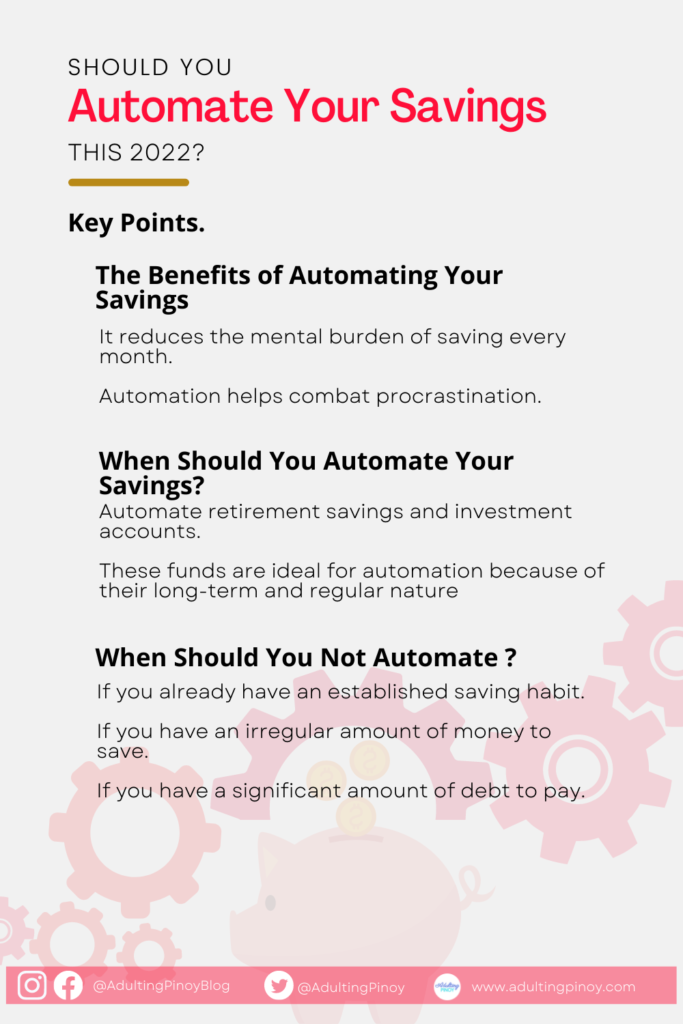If there’s one thing we can all agree on, it’s that saving money isn’t as easy as it seems.
As soon as we receive our hard-earned salaries, we start thinking about dividing them into our monthly bills, projects, and wants. By the time we get to saving, most — if not all — of the money are gone.
But if you automate your savings, you can combat this habit.
With automated deposits, we have the option of telling our bank to automatically transfer our money from one account to the other without our supervision. From the get-go, this strategy seems like it would make it easier for us to save because then we don’t have to go through the hassle of transferring every month.
But is it really the best way to save? Should everyone do it? That’s what we’re going to find out in this article.
The Benefits of Automating Your Savings
Automating your savings is an excellent move because it makes savings easy, and it has multiple benefits aside from that.

The first benefit is that automation minimizes any mental stress that comes with manually remembering to save some of the money you earned.
Procrastinating is a big battle we have to fight, especially about our money. Automating our savings helps get rid of that because it just takes a few swipes and clicks, and your bank will automatically transfer forever.
Second, automation relieves unpredictable, impulsive spending decisions.
We all find reasons to reward ourselves after a hard day’s work. Thus, having urges to spend the extra money we have on things that we may or may not need is pretty much normal. With automation, we can combat these urges and save ourselves in the long run.
By automating your savings, you won’t even have time to think about spending the extra money because it has already been set aside — especially if you set your automation the moment your salary arrives.
When Should You Automate Your Savings?
Pre-programming your savings will not only kick-start your journey to financial independence but will also create a free-flowing productive system.

By learning these tools, you can think less about the small details like fund allocations and the bigger picture. With this, you will now set up more openings to save for other things like debt, emergency funds, and the like.
Retirement funds.

Retirement funds are long-term investments. This isn’t talking about your regular GSIS or SSS savings, which are government-mandated and already happens automatically.
If you wish to save more money for your retirement (and you definitely should), then you’d better open another long-term savings account. And you’d want it to be automated.
Retirement funds tend to sit around for a while, so these accounts are ideal for your automated savings.
This is because the road to retirement is a long path. Imagine having to deposit money to a separate bank account every month until you’re more than 60 years old. The amount of discipline necessary for such a feat is no joke — small wonder not many Filipinos have any extra money during retirement except for their pensions.
And speaking of pensions, the success of programs such as SSS or GSIS can be primarily attributed to the fact that their savings are automatic. Imagine if every employee has to deposit their SSS, GSIS, Pag-Ibig, or Phil Health contributions every month, only a very few people can stick to it and the whole system will fail.
Thus, automation is essential for any long-term savings that you might want to make. It would also be best for you to choose high-interest rate savings to account for if you decide to do so.
Other types of accounts.
Other accounts, such as investment accounts and emergency funds, are ideal for automation.

While investment funds are there for when you quit the workforce, investment accounts exist to help you build wealth. On the other hand, emergency funds will be your safety net when you face a financial emergency, just like their name suggests.
These accounts are ideal for automated savings because they require repetitive deposits over long periods.
However, some investment accounts (like stocks, bonds, etc.) can only automate money coming in. Once you have your cash inside your account, you will have to buy the stocks with the money inside your account manually.
When should you not automate?
Although automation has many good benefits, it could lead to more significant problems instead of helping you.

Using too much technology might just teach us to become complacent with our savings. Yes, automation might help you out, especially when you’re just getting started, but if you’re already used to “manual ways” of saving, you don’t need to.
Plus, most automation programs by bank apps only work for a set amount of money every time.
If, for example, you don’t have regular amounts of money to save every month (for example, you keep 500 first month, 600 second month, and 300 third month), then automation won’t work for you.
This is true if you have big debts to pay as well because you’re most likely going to dedicate as much money as you can towards it every month.
As much as we try to, the reality is that not everyone can afford to put away a certain amount of money every month. If you’re one of those people, automation can just harm your financial health instead of improving it.
Taking Control of Your Financial Goals with Automation
Whether you choose to take advantage of automating your finances or not, it is essential to know the pros and cons. In this digital age, it is best to be careful and note how you spend your money.

This article discussed the pros and cons of automating your savings — but whether you do so is up to you.
Remember, balance is essential for achieving your personal goals, and you’re the only one who can determine that balance for yourself.









